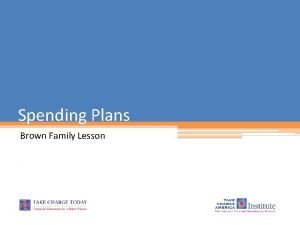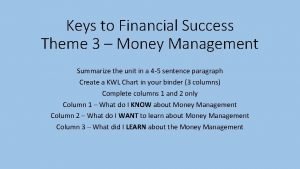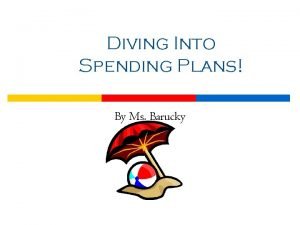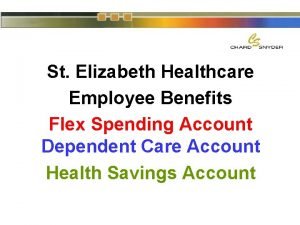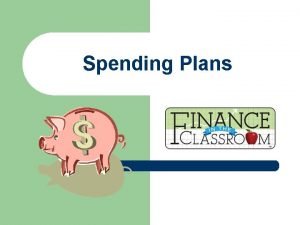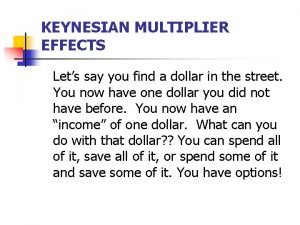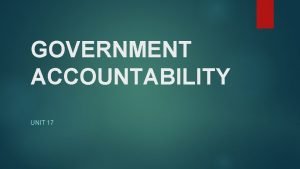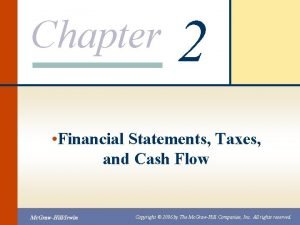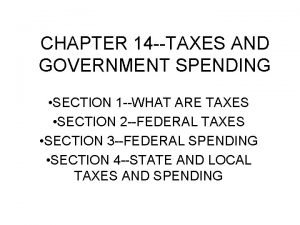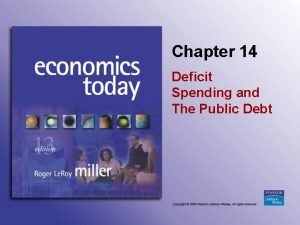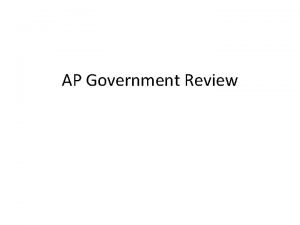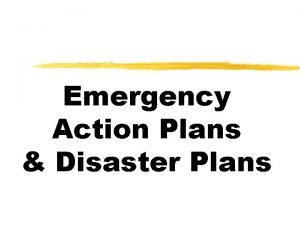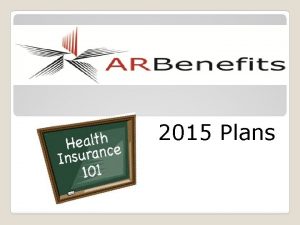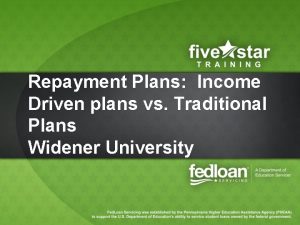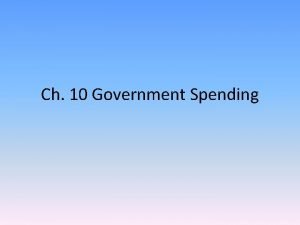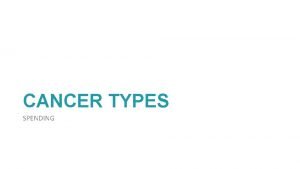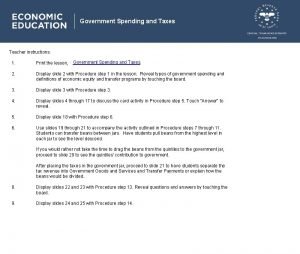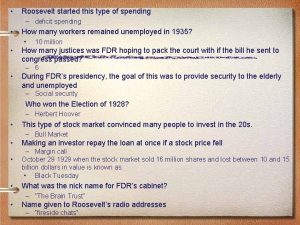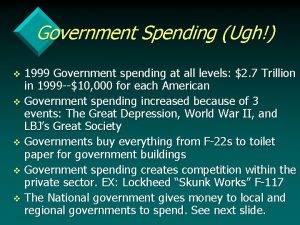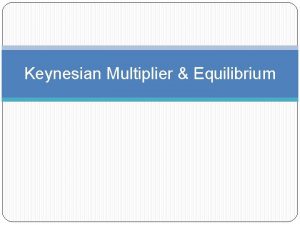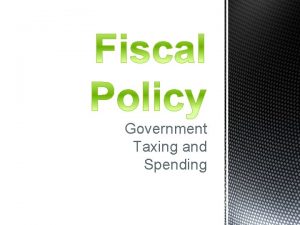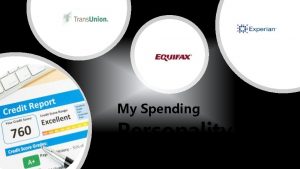Spending Plans What is a Spending Plan An



















- Slides: 19

Spending Plans

What is a Spending Plan? An income and expense statement sometimes referred to as a budget which records both planned and actual income and expenses over a period of time A budget

Why is a Spending Plan an important part of financial planning? Help manage your money in a positive manner Analyze the opportunity costs of your trade-offs to maximize financial wellbeing Helps set and reach goals Increase net worth

Spending Plan Pie Chart 10% 30% 20% Housing Transportation Food Insurance Other 10% 15% 5% 10% Saving Retirement

5 Steps of Budgeting Developing a Budget – Step 1 �Track current income and expenses �Individuals will determine what income and expenses they have within a give period of time � Usually concurrent with an individual’s pay day Monthly � Bi-monthly � Step 5– Evaluate and Make Adjustments Step 1 - Track Current Income and Expenses Step 2– Creating Step 4– Personalized Implement and Income and Control Expense Step 3– Allocate Categories Money to Each Category

Tracking Methods Must work for the individual! There is not one right method! 1. Carrying a small notebook and writing down all expenses 2. Keep all receipts 3. Use a debit card if your financial institution creates spending reports for your account 4. Input information into a cell phone

Creating personalized income and expenses categories – Step 2 �Each Budget is unique because of individual and family values �Categories are based upon the individuals/families income and expenses Step 5– Evaluate and Make Adjustments Step 1 - Track Current Income and Expenses Step 2– Creating Step 4– Personalized Implement and Income and Control Expense Step 3– Allocate Categories Money to Each Category

Housing �Housing is the largest of the four major expenditures �Approximately 30% of an individual’s net income Monthly payment (Mortgage) – A fee charged each month to live in a home � Utilities – include electricity, water, and garbage fees � Transportati on 10% 30% 20% Insurance 10% 5% Food 15% 10% Other Saving Retirement

Transportation �The second largest major expenditures �Approximately 15% of an individual’s net income � Monthly payment – is made if a loan is taken out to purchase a vehicle Housing Transportati on 10% 30% 20% Insurance 10% 5% Food 10% 15% Other Saving Retirement

Food �The third most expensive category within an individual’s Budget �Approximately 10% of an individual’s net income Housing Transportati on 10% 30% 20% Insurance 10% 5% Food 15% 10% Other Saving Retirement

Insurance �Arrangement between an individual and an insurance company to protect the individual against risk � Risk is uncertainty about a situation’s outcome �Approximately 5% of an individual’s income Housing Transportati on 10% 30% 20% Insurance 10% 15% 10% 5% Food Other Saving Retirement

Additional expenses �Savings and investing �Save 3 -6 months of income that is available in a liquid account for emergencies �Other �Fulfills additional needs and accounts for 10% of an individual’s net income Housing Transportati on 10% 30% 20% Food Insurance 15% 10% Other Saving Retirement

Allocate money to each category – Step 3 �Reference tracking from step one to be realistic about expenditures and income � Think if there were any unique Step 5– Evaluate and Make Adjustments Step 1 - Track Current Income and Expenses expenses in the past month that should be included �Consider changes that need to be made � Identify ways to implement that change �Consider financial goals and money that needs to be allocated Step 2– Creating Step 4– Personalized Implement and Income and Control Expense Step 3– Allocate Categories Money to Each Category

When allocating money consider: Trade-offs and opportunity costs Goals Contractual expenses Contractual Non-contractual Required to pay expense for a specific amount of time - not easy to reduce or eliminate Easy to reduce or eliminate Rent, Internet, Cell phone Food, entertainment

Implement and control – Step 4 �Must develop control systems to track their income and expenses Step 5– Evaluate and Make Adjustments Step 1 - Track Current Income and Expenses 1. Envelope systems – individuals place the actual budget amount of cash from a paycheck into a specific envelope system for the expense 2. Electronic budgeting systems – Multiple types of software available for consumers to use to help keep track of their financial records Step 2– Creating Step 4– Personalized Implement and Income and Control Expense Step 3– Allocate Categories Money to Each Category

Evaluate and make adjustments – Step 5 �Assess if Budget is working �Make changes if necessary �Analyze if goals are being met �Begin the process again Step 5– Evaluate and Make Adjustments Step 1 - Track Current Income and Expenses Step 2– Creating Step 4– Personalized Implement and Income and Control Expense Step 3– Allocate Categories Money to Each Category

Bathtub Analogy Always have more money coming in than out! Work towards. Wages, building wealth! interest, and tips… all income is Revenue �Revenue (money in) �Net worth (wealth) �Flexible Expenses (money out) - can vary each month in the amount owed and are not contractual �Fixed Expenses (money out) - may have a fixed amount due each month and are contractual

Net worth statement Assets Liabilities Net Worth �A net worth statement describes an individual or family’s overall financial condition on a specified date �The components include: � Assets – Everything a person owns with monetary value � Liabilities – Debts or what is owed to others � Net worth - the amount of money left when liabilities are subtracted from assets (indicates wealth)

Who is Wealthier? Juanita – earns $35, 000 per year Assets Home $60, 000 Retirement $24, 000 Automobile $8, 000 Total Assets $92, 000 Liabilities College loan $6, 000 Mortgage $35, 000 Total Liabilities $41, 000 Net Worth $51, 000 Alexis – earns $100, 000 per year Assets Home $75, 000 Retirement $35, 000 Automobile $8, 000 Total Assets $118, 000 Liabilities College loan $10, 000 Automobile loan $4, 000 Credit card debt $20, 000 Mortgage $65, 000 Total Liabilities $99, 000 Net Worth $19, 000
 Spending plan shake up
Spending plan shake up The brown family spending plan
The brown family spending plan John and marcia monthly spending plan 1 answer key
John and marcia monthly spending plan 1 answer key Fun budgeting activities for adults
Fun budgeting activities for adults Why is evaluating and adjusting a spending plan important
Why is evaluating and adjusting a spending plan important Spending plan shake up
Spending plan shake up Cash flow to creditors
Cash flow to creditors St elizabeth benefits
St elizabeth benefits What is spending
What is spending Moderate spending
Moderate spending Tax multiplier formula
Tax multiplier formula Tax multiplier
Tax multiplier Budget multiplier
Budget multiplier Answer
Answer Cash flow to creditors
Cash flow to creditors Cash flow to creditors
Cash flow to creditors Chapter 14: taxes and government spending section 1
Chapter 14: taxes and government spending section 1 Deficit spending exists when
Deficit spending exists when Government spending multiplier formula
Government spending multiplier formula Uncontrollable spending definition ap gov
Uncontrollable spending definition ap gov

